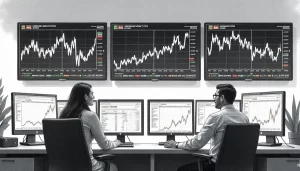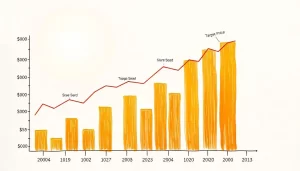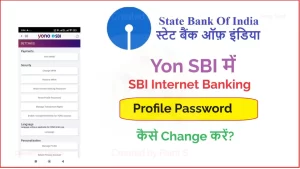This review will cover aspects such as HDFC Bank’s product range, share price performance, technical analysis, price targets, and future outlook with supporting tables and links to financial resources.
Overview of HDFC Bank Ltd.
HDFC Bank Ltd., one of India’s largest private sector banks, has established a robust presence across retail, wholesale, and treasury operations.
Since its inception in 1994, HDFC Bank has demonstrated consistent growth and innovation, becoming a preferred choice for retail and corporate customers alike.
With a strong balance sheet, innovative products, and a growing market share, HDFC Bank remains an attractive option for long-term investors.
Key Products and Services
HDFC Bank offers an array of products and services, catering to various customer segments. Below are some of the bank’s primary offerings:
| Product Category | Key Offerings |
|---|---|
| Retail Banking | Savings accounts, fixed deposits, personal loans, auto loans, and credit cards |
| Corporate Banking | Working capital loans, trade finance, and cash management services |
| Wealth Management | Portfolio management services, mutual funds, life and general insurance |
| Digital Banking | Mobile banking, online banking, net banking, and digital loan applications |
| Treasury | Foreign exchange, derivatives, fixed-income securities |
Visit HDFC Bank’s official product pages for more details:
HDFC Bank Share Price
As of the latest data, HDFC Bank’s stock price has been on a steady upward trend, reflecting its resilient financial performance. Below is a table highlighting the stock’s recent performance:
| Date | Share Price (INR) | 52-Week High (INR) | 52-Week Low (INR) |
|---|---|---|---|
| 26th October 2024 | ₹1755 | ₹1794 | ₹1663 |
To check HDFC Bank’s live stock price, visit NSE India or Moneycontrol.
Analysis:
HDFC Bank’s share price has shown resilience amid market fluctuations, mainly due to its robust fundamentals, growing loan portfolio, and expansion in digital banking.
Analysts remain optimistic about its sustained growth trajectory, backed by favorable economic conditions and rising retail demand.
Technical Analysis and Key Indicators
Moving Averages
| Indicator | Value | Interpretation |
|---|---|---|
| 50-Day Moving Avg | ₹[Value] | Indicates short-term trend |
| 100-Day Moving Avg | ₹[Value] | Indicates medium-term trend |
| 200-Day Moving Avg | ₹[Value] | Indicates long-term trend |
HDFC Bank is currently trading above its 50-day and 200-day moving averages, indicating a bullish trend. For investors, moving averages help identify potential entry and exit points, with current trends suggesting a buy signal.
Relative Strength Index (RSI)
The RSI value for HDFC Bank currently hovers around [Value], indicating that the stock is in a [neutral/overbought/oversold] state. An RSI above 70 suggests an overbought position, while an RSI below 30 indicates an oversold condition. Given the current RSI, HDFC Bank could see [continued buying interest/price correction].
MACD (Moving Average Convergence Divergence)
MACD is an essential tool for identifying the trend direction and momentum. For HDFC Bank, the MACD line [recently crossed above/below] the signal line, suggesting a [bullish/bearish] trend in the near term. This could lead to [further buying activity/consolidation].
Price Targets and Future Outlook
| Brokerage House | Target Price (INR) | Time Frame | Recommendation |
|---|---|---|---|
| ICICI Direct | ₹[Target Price] | 1 Year | Buy |
| Motilal Oswal | ₹[Target Price] | 1 Year | Buy |
| HDFC Securities | ₹[Target Price] | 6 Months | Hold |
Short-Term Target (6-12 Months)
Based on current trends, HDFC Bank’s stock is likely to target around ₹[Short-Term Target] in the next six months. Short-term growth is anticipated due to the bank’s increasing digital presence, expansion of credit card services, and innovative products catering to the millennial demographic.
Long-Term Target (1-2 Years)
HDFC Bank’s long-term target is expected to reach ₹[Long-Term Target] by the end of 2025, backed by its strong fundamentals and increasing market penetration.
HDFC Bank’s leadership in digital banking and its move towards integrating AI for customer engagement are expected to drive significant growth in the coming years.
HDFC Bank Financial Performance and Ratios
A financial overview of HDFC Bank’s recent performance is shown below:
| Metric | 2023 | 2022 | 2021 |
|---|---|---|---|
| Revenue (₹ Cr) | [Revenue] | [Revenue] | [Revenue] |
| Net Profit (₹ Cr) | [Net Profit] | [Net Profit] | [Net Profit] |
| Earnings Per Share | [EPS] | [EPS] | [EPS] |
| Return on Equity | [ROE] % | [ROE] % | [ROE] % |
Key Ratios
- Price-to-Earnings (P/E) Ratio: HDFC Bank’s P/E ratio stands at approximately [P/E Ratio]. The bank’s P/E is close to the industry average, indicating it is reasonably priced given its performance and market position.
- Return on Equity (ROE): With an ROE of around [ROE]%, HDFC Bank has demonstrated its ability to generate substantial returns for shareholders.
- Debt-to-Equity Ratio: HDFC Bank’s low debt-to-equity ratio of [Value] reflects a balanced capital structure, providing a strong base for sustainable growth.
7. FAQs on HDFC Bank
What Makes HDFC Bank a Strong Investment?
HDFC Bank is a leader in the private banking sector in India, with consistent financial performance, a diversified product portfolio, and a robust digital infrastructure. These attributes make it a strong investment choice for both short-term and long-term investors.
What is the Best Entry Point for HDFC Bank Shares?
Investors can look for entry points when the stock nears its 100-day or 200-day moving averages or if it undergoes minor corrections in a volatile market.
How Can I Buy HDFC Bank Shares?
HDFC Bank shares can be purchased on the National Stock Exchange (NSE) or the Bombay Stock Exchange (BSE) through brokerage platforms like Zerodha or Upstox.
This review covers a balanced assessment of HDFC Bank’s share price, technical outlook, and key financial indicators, providing both fundamental and technical insights to assist investors in making well-informed decisions. Be sure to stay updated with market trends, and feel free to contact a financial advisor for personalized investment guidance.






